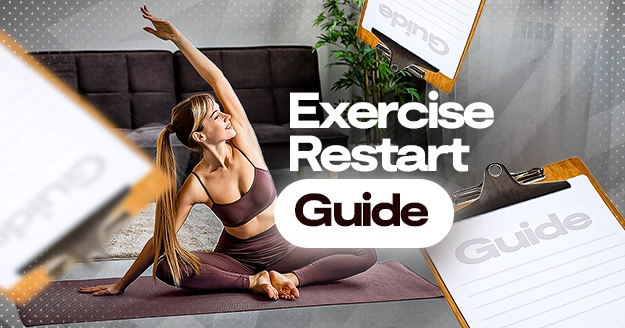Life has a way of throwing us off our routine, and exercise is usually one of the first things we let go of when we’re faced with challenges.
But undeniably, exercise is beneficial in many ways. Besides the physical benefits, it can also boost your self-esteem, improve your mood, and help you get quality sleep. Hence, getting back into exercise is what most people on hiatus choose to do. Exercising after an injury, a busy schedule, or health issues can be challenging, especially if you lose motivation or do not know where to start. However, it is in your best interest to slowly ease back into your routine safely and effectively with a thoughtful approach and dedication to getting back into shape.
The Importance of Returning to Exercise Safely
A simple few weeks of inactivity can lead to significant losses in muscle strength, neurological awareness, and joint flexibility. Additionally, there will also be changes in your digestion, circulation, and hormone production which may affect your capacity to exercise.
It is important to note that while on a break, your body may undergo drastic changes. Your muscles, joints, and cardiovascular system may not be as strong and resilient as it was before your break. Your body needs time to readjust to the demands of regular exercise. Therefore, knowing how to safely resume exercising when you are ready is essential to help your body regain its strength and rebuild muscles safely.
Tips to Help You Safely Get Back on Track After a Break
- Assess your body and fitness level
Before getting back into working out, take into account your fitness level to avoid injury and ensure a smooth transition back into your routine. This can include assessing your cardiovascular endurance, flexibility, strength, existing injuries, or any physical limitations that may hinder you from doing some exercise routines. At some point, you may still feel soreness or fatigue when getting back into exercise after a break. Make a conscious effort of giving yourself ample time to recover when your body signals you to do so.
For a thorough assessment, you may consult with a healthcare professional or a fitness expert to provide you with a personalized insight and help you establish a safe and effective workout plan. This assessment will help you to tailor your new exercise routine to your current abilities, set realistic goals, and avoid overexertion.
By understanding your body’s limitations, you can reintroduce physical activity in a balanced and sustainable way.’
- Start Slowly
Slowing down your workout is fine. It is not just a cautious strategy but also a powerful foundation for lasting success in your fitness journey. Remember that it is very important to ease back into exercise to avoid further injury and burnout. Do not rush things by trying to do too much too soon. Starting slowly allows you to fine-tune your technique and form, which is essential for performing exercises correctly and maximizing their benefits. Then, as you progress, you can start challenging yourself, leading to consistent improvements and a good workout cycle.
As a starter, you may begin with low-intensity workouts such as:
- Brisk walking
- Biking
- Yoga
- Swimming
- Zumba
- Resistance band training
- Light dumbbell exercises
- Pilates
- Tai Chi
- Aerobics
Low-intensity workouts can have significant positive effects on both physical and mental health. They improve blood flow, prevent falls and injuries, and provide a pleasurable experience that may increase the likelihood of sticking with it. Engaging in enjoyable activities like low-intensity workouts can reduce stress, improve mood, and enhance overall energy levels. Additionally, mixing up your routine can prevent boredom and keep you motivated.
- Track your Progress and Be Consistent
Monitoring your progress can help keep you motivated and accountable. You can use fitness apps or wearable technologies to track your progress and celebrate small wins. Managing fitness progress has been revolutionized, making it easier and more effective than ever before. This social aspect can be a powerful motivator, as sharing and seeing your progress can provide you with a sense of achievement and boost your commitment and enjoyment.
Moreover, being consistent with your workout schedule is the building block to maintaining fitness. Starting with small yet achievable goals is important for making progress. Creating a regular exercise schedule and following it consistently can help you sustain the habit and stay on track. Irregular workouts can lead to fluctuating results. Thus, following a regular schedule fosters gradual yet sustainable improvements.
- Focus on yourself
Make your comeback into fitness about you. Learn what works best for you. After all, we differ on the settings or strategies that best fit us. Some are comfortable exercising at home, while others prefer working out with peers at the gym.
Avoid comparing your progress to that of others. You improve at your own pace. In a world where comparison is easy, especially with the proliferation of social media, it’s important to remember that everyone’s body and progress are unique. Fitness is your personal journey with your body, and what works for someone else might not work for you. As long as you stick to your plan and hit your workout targets, there is nothing to worry about. Focus on what you can do now instead of thinking about what you used to achieve before.
Additionally, focusing on yourself means listening to your body and acknowledging its signals. Take note of how each exercise makes you feel, both physically and mentally.
- Have Recovery Days
Do not rush into exercising and expect immediate results. Working out is all about balance. As tempting as it is to exercise continuously, especially if you are already noticing some progress, you must give your body the necessary rest it deserves. By valuing recovery, you ensure that your body remains balanced and capable of progressing toward your fitness goals.
Moreover, recovery days are essential not only for your physical health but also for your mental rejuvenation. Taking time off helps refresh your mind and maintain a positive attitude towards exercise. Recovery days can increase your motivation, leading to long-term success and enjoyment in physical activity. They ensure that you are not just going through the motions but truly enjoying and benefiting from your workouts.
So you may ask, “should I take a break from exercise?” The answer is Yes. During these times, you give your bones and muscles the necessary time to repair and strengthen between workouts. Recovery days allow you to build a strong and resilient body over time.
Conclusion
Getting back into shape after a break can be tough but rewarding. It requires patience, dedication, and a strategic approach. By assessing what your body can and cannot do, starting slowly while incorporating enjoyable activities, tracking your progress, being consistent, focusing on yourself rather than others, and giving yourself a chance to recover with recovery days, you are safely easing your way back into working out.
Each of these tips will help you reconnect with your body, build a routine, and avoid burnout or injury. Remember, the goal is not just to get back to where you were before your break, but to move forward with a deeper understanding and respect for your health. Embrace your journey with patience and commitment, and you’ll come back stronger, more motivated, and more in sync with your body than ever before.








